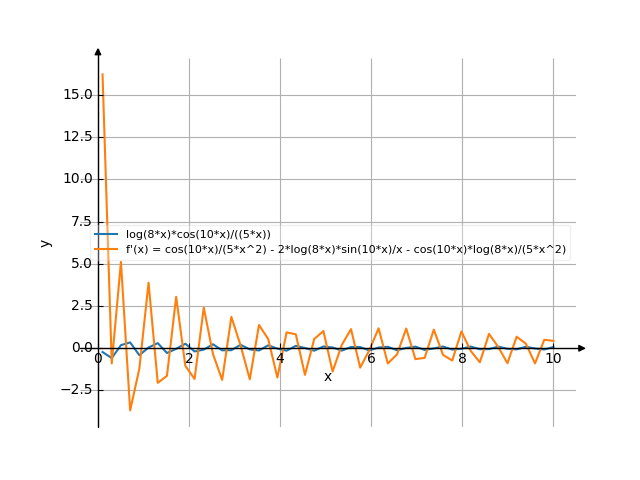Derivative of y=(ln8x*cos10x)/(5x)
The solution
log(8*x)*cos(10*x)
------------------
5*x
d /log(8*x)*cos(10*x)\ --|------------------| dx\ 5*x /
-
Apply the quotient rule, which is:
and .
To find :
-
Apply the product rule:
; to find :
-
Let .
-
The derivative of cosine is negative sine:
-
-
Then, apply the chain rule. Multiply by :
-
The derivative of a constant times a function is the constant times the derivative of the function.
-
Apply the power rule: goes to
So, the result is:
-
The result of the chain rule is:
-
; to find :
-
Let .
-
The derivative of is .
-
-
Then, apply the chain rule. Multiply by :
-
The derivative of a constant times a function is the constant times the derivative of the function.
-
Apply the power rule: goes to
So, the result is:
-
The result of the chain rule is:
-
The result is:
To find :
-
The derivative of a constant times a function is the constant times the derivative of the function.
-
Apply the power rule: goes to
So, the result is:
-
Now plug in to the quotient rule:
Now simplify:
The answer is:
1
---*cos(10*x)
5*x 1 cos(10*x)*log(8*x)
------------- - 10*---*log(8*x)*sin(10*x) - ------------------
x 5*x 2
5*x
4*sin(10*x) 3*cos(10*x) 4*log(8*x)*sin(10*x) 2*cos(10*x)*log(8*x)
-20*cos(10*x)*log(8*x) - ----------- - ----------- + -------------------- + --------------------
x 2 x 2
5*x 5*x
------------------------------------------------------------------------------------------------
x
60*cos(10*x) 18*sin(10*x) 11*cos(10*x) 12*log(8*x)*sin(10*x) 60*cos(10*x)*log(8*x) 6*cos(10*x)*log(8*x)
- ------------ + ------------ + 200*log(8*x)*sin(10*x) + ------------ - --------------------- + --------------------- - --------------------
x 2 3 2 x 3
x 5*x x 5*x
--------------------------------------------------------------------------------------------------------------------------------------------
x


![Find the derivative of y' = f'(x) = y=(ln8x*cos10x)/(5x) (y equally (ln8x multiply by co sinus of e of 10x) divide by (5x)) - functions. Find the derivative of the function at the point. [THERE'S THE ANSWER!] y=(ln8x*cos10x)/(5x)](/media/krcore-image-pods/176/hash/derivative/b/b4/7aecf84b2fac11b94d56c06b8e5c5.png)
 Derivative of y=2x+1
Derivative of y=2x+1
 Derivative of asin(t)
Derivative of asin(t)
 Derivative of 7/x^4
Derivative of 7/x^4
 Derivative of x*sin(4*x)
Derivative of x*sin(4*x)